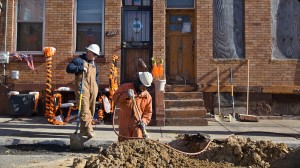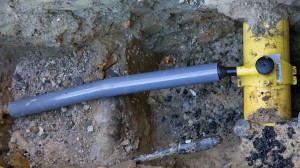Study: Gas utilities reduce leaks but more work needed

Kevin McDonald, PGW Senior Pipe Mechanic uses a compressor to back fill soil covering main and service pipelines in North Philadelphia.
Some gas utilities are doing a better job of reducing methane leakage but need to do more to stop the escape of the potent greenhouse gas from their pipelines, according to a new study.
The report from Washington State University found methane emissions at 13 utilities were 36-70 percent lower than last time they were measured in the early 1990s, thanks to better leak detection and repair; infrastructure upgrades, and new rules at state and federal levels.
The utilities have replaced 40 percent of the old cast-iron pipes that cause the most leaks and which were in service in 1990, the study found, citing data from the federal Pipeline and Hazardous Materials Safety Administration.
But the remaining 60 percent of old piping, like some of that in Philadelphia, remains in the ground, and will take another 50 years to replace at the current rate, according to the the study, which was conducted in 2013 and released on Tuesday.
Of 230 leaks detected, 50 percent of the total emissions came from just three locations, showing that utilities should focus on the size of individual leaks rather than their number, said Jonathan Peress, Air Quality Director for Natural Gas at the Environmental Defense Fund, which funded the study.
“The most important thing they can do is leak detection and quantification so that they can find the super-emitters and quickly repair those,” he told StateImpact Pennsylvania.
Methane’s strong contribution to greenhouse gas emissions has been highlighted by Cornell University Professor Robert Howarth who argues that both shale gas and conventional natural gas emit more GHGs than coal and oil because of methane leakage, despite the fact that natural gas emits less CO2 than the other two fuels when it is burned.
StateImpact Pennsylvania recently reported on efforts to measure the climate trade-offs of replacing natural gas with coal.
The Obama administration has set a target to cut leakage of methane, the major component of natural gas, by 40-45 percent from 2012 levels by 2025.
In Philadelphia, some 6,000 miles of gas piping, some of it dating back to the 1890s, is being slowly replaced by Philadelphia Gas Works, the local City-owned utility. The process could have quickened under a plan to sell PGW to UIL, an energy-distribution company, but the deal was rejected by Philadelphia City Council in late 2014, and the pipe-upgrade program is now expected to take another 87 years.
Peress urged utilities and public officials to expand and accelerate the detection and repair of leaks, and to directly measure the amount of methane escaping in order to prioritize repair projects.
“A small number of leaks cause a large share of emissions with big differences among utilities and regions,” the study noted. “Both facts suggest case-by-case data is more telling than national averages.”
About 40 states have replacement programs for leak-prone utility pipes, and 15 require leak classification and repair timelines, the study said. At a federal level, the Environmental Protection Agency now requires gas utilities to measure and report methane leaks from metering and regulating equipment.

Philadelphia Gas Works crew members activate new plastic main lines (right) and service lines in North Philadelphia as part of an ongoing program to replace the aging cast-iron pipelines throughout the city.
Although repair work, such as that going on in Philadelphia, has focused on ageing cast-iron pipes, newer pipes can also be a major source of leaks, Peress said, noting that the second-biggest leak in the study was founded in a plastic pipe.
More than a third of the leaks detected were in the U.S. Northeast, and 70 percent of those were from old iron and steel pipes, the study said.
While it found some reduction in methane leakage, participants were self-selecting utilities that are already replacing pipeline, and who represent less than 1 percent of the country’s approximately 1,400 utilities, Peress said.
And however successful they are in stopping leaks, their efforts may pale by comparison to methane emissions by natural gas producers – which are the subject of an earlier study in a series of reports that will eventually include 16 parts, he said.
“Leaks from the production stage are a much bigger piece of the pie than they are from distribution,” he said.
















